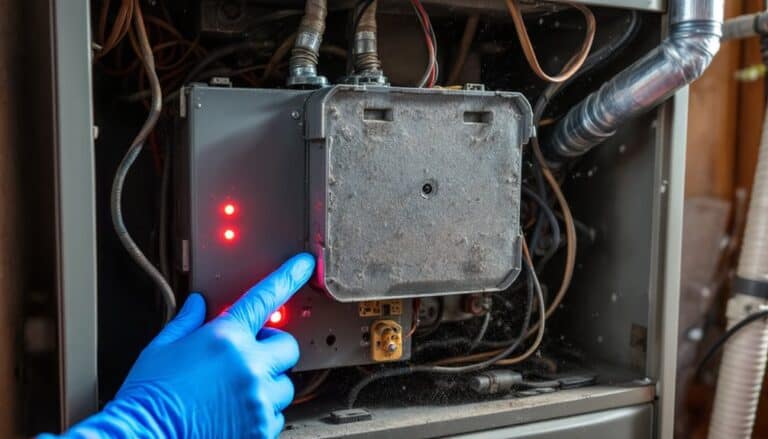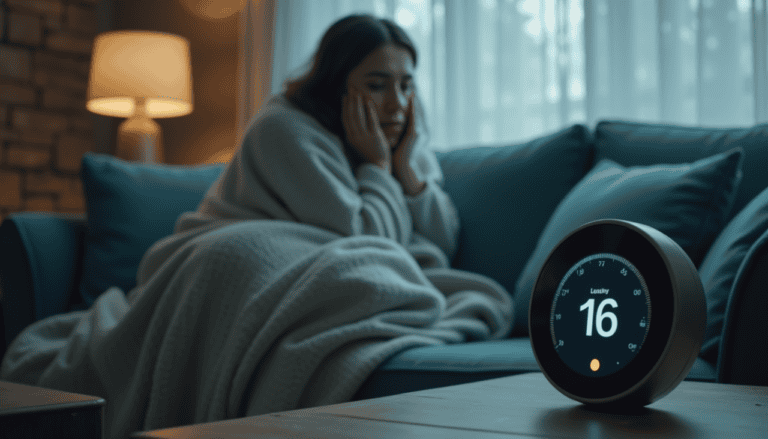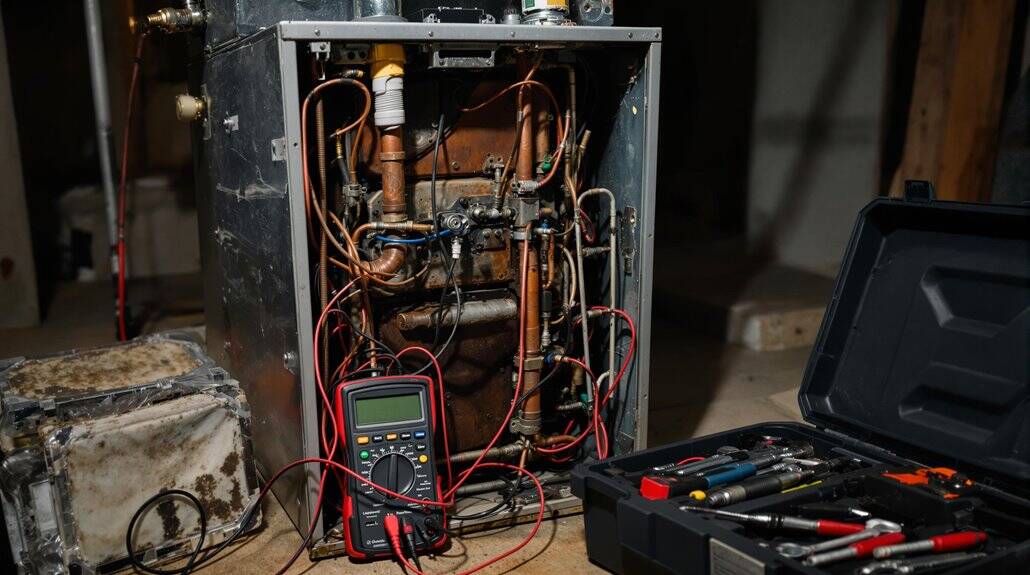If your furnace isn’t working properly or the furnace appears broken, start with the basics: check your thermostat settings, inspect circuit breakers, and verify clean air filters.
Common issues include pilot light problems, faulty ignition systems, and airflow blockages – many of which you can fix yourself. For mechanical issues, listen for unusual noises and check for loose components. While some repairs are DIY-friendly, complex electrical problems or persistent malfunctions require professional expertise. The following guide explores these solutions in detail.
Key Takeaways
Simple Steps for a Reliable Furnace:
- Start with the basics: A quick check of thermostat settings, batteries, and breakers can show you how to fix a furnace without needing a service call.
- Keep airflow strong: Monthly air filter maintenance prevents unnecessary wear, reduces energy costs, and maintains consistent heating throughout your home.
- Restore heat quickly: Address pilot light or ignition system issues with a simple cleaning or relighting process to get your heat back within minutes.
- Prevent costly repairs: Identify and fix loose parts early when you hear unusual sounds, saving money and extending your furnace’s lifespan.
- Maintain steady heating: Regular checks of gas supply and valve positions ensure reliable warmth when you need it, preventing unexpected outages.
Each solution focuses on practical fixes that keep your furnace running efficiently, reduce repair costs, and maintain consistent home comfort without requiring professional help for minor issues.
Common Issues with Furnace and Their Solutions
When your heating system not working, you’ll likely encounter some common issues that include no heat production, cold air blowing through vents, frequent system shutdowns, unusual noises during startup, or an unresponsive thermostat. These problems can stem from various sources, including dirty filters, faulty ignition systems, thermostat malfunctions, or mechanical wear and tear, often requiring heating system repair to restore functionality. If you’re experiencing any of these issues, it’s important to identify the root cause quickly and contact a licensed HVAC technician to prevent more serious damage to your heating system.
Furnace Not Heating
What’s Happening?
Your furnace is running, but the house still feels cold. This usually points to a handful of common issues.
Possible Causes:
- Incorrect thermostat settings
- Tripped circuit breaker
- Clogged air filter
- Ignition system failure
- Fuel supply problem
Quick Checkes:
- Is the thermostat set to Heat and the batteries working?
- Has a breaker tripped?
- When did you last change the air filter?
When To Call a Pro
Sometimes, a no-heat problem isn’t a quick fix. Call an HVAC technician if you notice:
- A gas smell or carbon monoxide alarm
- Loud banging, screeching, or buzzing noises
- Furnace cycling on and off frequently
- A yellow or flickering pilot light
Simple issues like dirty filters or tripped breakers you can fix yourself, BUT, leave complex repairs such as electrical issues, ignition failures, or a cracked heat exchanger – That’s expert territory. Don’t risk safety or voiding your warranty
Furnace Blowing Cold Air
What’s Happening?
Your furnace runs, but the air feels like it’s straight from the Arctic. This usually points to a few common issues.
Possible Causes:
- Thermostat set to Cool or fan set to On
- Dirty air filters restricting airflow
- Furnace overheating and shutting down the burners
- Ignition system failure
- Leaky air ducts
Quick Checkes:
- Is the thermostat set to Heat and the fan on Auto?
- When did you last replace the air filter?
- Any visible gaps or leaks in the ductwork?
When To Call a Pro
Call a heating professional immediately if you notice:
- Gas smells or carbon monoxide detector alerts
- Strange noises from the furnace
- Electric control board failures
- Faulty ignition systems
- Cracked heat exchangers
- Gas supply issues
- Blower motor problems
Don’t attempt DIY on anyting involving gas lines or connections, complex electrical components or Internal mechanical parts.
Any problem that persists after basic troubleshooting needs professional diagnosis and repair.
Furnace Keeps Shutting Down

What’s Happening?
Your furnace starts heating but shuts off before your home warms up.
Possible Causes:
- Dirty air filters blocking airflow
- Closed or obstructed air vents
- Oversized furnace short cycling
- Malfunctioning thermostat
- Dirty flame sensor misreading the flame
Quick Checkes:
- Replace or clean the air filter
- Open all vents for proper circulation
- Check thermostat batteries and settings
When To Call a Pro
If your furnace still shuts down after basic troubleshooting, call an HVAC technician if you notice:
- Your furnace continues to short cycle after basic maintenance
- Carbon monoxide detectors signal an alert
- The exhaust vent shows signs of blockage
- Your blower motor fails or runs inefficiently
- Flame sensor issues persist
- The furnace shows signs of being oversized for your home
Remember: DIY ends where gas lines, electrical components, or heat exchangers begin. These repairs require professional expertise and proper tools to guarantee safety.
Quick tip: While waiting for professional help, guarantee your thermostat settings are correct and air filters are clean to rule out simple fixes.
Furnace Makes Loud Noise When Turning On
What’s Happening?
Hearing a bang, squeal, or rattle when your furnace fires up?
Possible Causes:
- Banging: Delayed ignition from gas buildup
- Squealing: Blower motor belt problems
- Rattling: Loose components or cracked heat exchanger
- Buzzing: Electrical or loose panel issues
- Popping: Aging equipment or ductwork expansion
Quick Checkes:
- Replace dirty air filters to improve airflow
- Check thermostat settings and reset the system
- Tighten loose panels and lubricate the blower motor
When To Call a Pro
If the furnace noise persists after basic troubleshooting, call an HVAC technician if you notice:
- Loud banging at startup
- Persistent squealing or grinding
- Rattling that could signal a cracked heat exchanger
- Any sound paired with gas smells or electrical issues
Never attempt to:
- Fix gas-related issues
- Repair electrical components
- Modify internal furnace parts
- Adjust gas pressure settings
- Repair the heat exchanger
Professional help guarantees safe, proper repairs and prevents dangerous situations involving gas or electrical components.
Furnace Thermostat Won’t Turn On

What’s Happening?
Your thermostat stays blank or unresponsive, leaving your furnace stuck in the off position.
Possible Causes:
- Dead batteries or tripped circuit breaker
- Loose wiring connections
- Incorrect mode or temperature settings
- Faulty electrical circuits
- Thermostat placement near heat sources
Quick Checkes:
- Replace batteries and check the circuit breaker
- Set the thermostat to Heat mode with the fan on Auto
- Inspect for loose wires and proper temperature settings
When To Call a Pro
If your furnace thermostat still won’t turn on after basic troubleshooting, it’s time for expert help. Call an HVAC technician if:
- Your furnace has complex electrical problems
- Your thermostat malfunctions persist despite resets
- Major furnace components need repair or replacement
- You smell gas or notice other safety hazards
Tried everything and still no luck? It’s time to bring in an HVAC technician.
Water Leaking from Furnace

What’s Happening?
Noticed a puddle around your furnace? That usually points to condensation issues, clogged drain lines, or a faulty condensate pump.
Possible Causes:
- Blocked drain lines or condensate traps
- Condensation pump failure
- Humidifier malfunctions in conventional furnaces
- Vent pipe or air return blockages
Quick Checkes:
- Clear drain lines with hot water or vinegar
- Replace dirty air filters
- Inspect drain line connections and the pump’s operation
When To Call a Pro
If leaks persist after basic troubleshooting, call an HVAC technician if:
- Internal furnace components need repair
- Condensate pumps or drain lines fail
- Jobs require specialized tools or technical expertise
- There are signs of water damage near the furnace
- Safety risks, like gas-related issues, arise
Remember: Temporary fixes might slow the leak, but professional service ensures long-term safety and efficiency.
Furnace Fan Stopped Working
What’s Happening?
Your furnace fan starts and stops unexpectedly.
Possible Causes:
- Clogged air filters restricting airflow, causing overheating and shutdown
- Faulty thermostat signals triggering the fan to cycle incorrectly
- Tripped limit switch shutting off the fan to prevent overheating
- Electrical issues like blown fuses or weak capacitor
- Worn-out blower motor components struggling to maintain consistent operation
Quick Checkes:
- Replace dirty air filters to restore proper airflow
- Verify thermostat settings (set to Heat and fan mode to Auto, not On)
- Reset any tripped circuit breakers and check for blown fuses
- Clear vents and returns from furniture or debris
- Inspect the furnace’s power switch and fan limit switch
When To Call a Pro
If the fan still won’t work after basic troubleshooting, call an HVAC technician if you notice:
- Burning odours from the furnace
- Repeated tripped breakers or blown fuses
- Strange noises or vibrations
- No heat, even when the system runs
- Signs of corrosion, damaged wiring, or water leaks
Routine annual furnace maintenance can prevent most fan issues, while frequent failures might signal it’s time for an upgrade.
Furnace Ignition Problems
What’s Happening?
Your furnace clicks but won’t light, or it starts and shuts off repeatedly.
Possible Causes:
- Faulty ignitor or pilot light
- Incorrect thermostat settings or dead batteries
- Tripped circuit breakers or blown fuses
- Closed gas supply valve or dirty burners
- Worn-out blower motor components
Quick Checkes:
- Reset the thermostat and replace batteries if needed
- Ensure the gas valve is open
- Check the circuit breaker and reset if tripped
- Clean dirty air filters and burner components
When To Call a Pro
You can call an HVAC technician if the furnace still won’t ignite after the above troubleshooting or if you notice:
- Electrical problems requiring licensed expertise
- Gas line issues or valve malfunctions
- Repeated ignition failures
- Strange noises or burning smells
- Complex component failures like control boards
Key reasons to avoid DIY repairs: DIY repairs on gas and electrical components can be dangerous and may void your warranty.
Remember: Attempting complex furnace repairs yourself can create dangerous situations and lead to costlier damage.
Other Common Furnace Problems
While we’ve covered the most common furnace problems, other issues can still disrupt your heating system. A stuck motor, blocked drain, tripped breaker, or uneven heating often point to component wear, airflow restrictions, or electrical faults. Click on any of the topics below to explore detailed guides, troubleshooting tips, and signs it’s time to call a professional.
Furnace problems Troubleshooting Checklist
A simple checklist helps homeowners with troubleshooting heater problems, identifying and resolving common heating issues before calling a professional. To maintain best furnace safety and heating efficiency, follow these essential checks:
| System Component | Action Required |
|---|---|
| Thermostat | Verify power, settings, and clean debris |
| Filter & Vents | Check for blockages and proper installation |
| Power Supply | Inspect breakers, fuses, and emergency switches |
Start with basic checks like thermostat settings and filter cleanliness. If you notice any concerning issues during your inspection, don’t hesitate to contact a qualified HVAC technician for a professional assessment and repair.
When Should You Call an HVAC Professional?
While basic troubleshooting can resolve some furnace issues, knowing when to seek professional help guarantees your safety and prevents costly damage.
Don’t attempt complex repairs involving electrical components or gas lines yourself. Regular Inspections by certified technicians can identify potential problems before they become emergencies. If you experience sudden spikes in energy bills or notice your system cycling more frequently than usual, it’s time to contact a licensed HVAC professional for a thorough evaluation.
Why Choose ALP Heating
ALP Heating stands out as Vaughan’s top HVAC service provider. As a family business with over 200 five-star reviews, we’ve earned our reputation through dedication to quality and customer satisfaction.
Our technicians are TSSA-licensed professionals who prioritize your safety and comfort. We offer same-day emergency service, thorough maintenance plans, and work with leading HVAC brands.
Conclusion
Your furnace doesn’t have to be as unreliable as a sundial in winter. When you’re facing heating issues, start with the basic troubleshooting steps we’ve outlined, but don’t hesitate to call a professional for complex problems. At ALP Heating, we’re committed to keeping your home warm with prompt, expert service.








